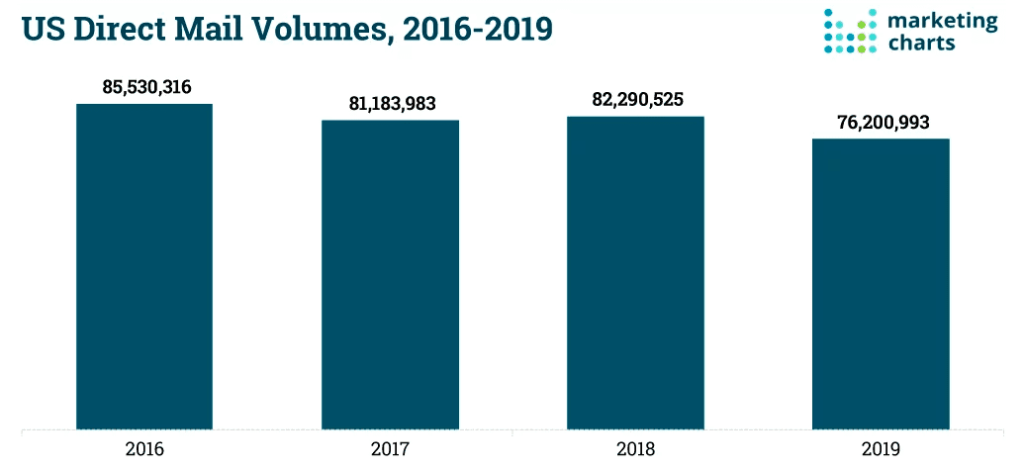5 direct mailer strategies to boost your success rate
Direct mail is making a quiet come back against the odds. We spoke with dozens of marketers to find out whether it works or not.

Direct mail is making a quiet come back against the odds. We spoke with dozens of marketers to find out whether it works or not.

You came here because you’re wondering about the effectiveness of direct mailers.
The answer? It depends.
Whether direct mail works for you will depend on your product or service and target audience.
The good news is that we spoke with marketers who’ve seen success and, more importantly, failure using mailers.
What became clear from our conversations is that direct mail campaigns work best for those selling high-value items–think cars and real estate.
Here’s what else we found.
The argument for direct mail is simple: since so many people have moved to digital, physical mail is cheaper than ten years ago and works better since less of it is sent out.

This is the logic that drove Strong Automotive Merchandising to make direct mail one of the pillars of its clients’ strategies.
Luke Thomas, who heads up the company’s PR department, tells us the car dealership marketing agency has seen a lot of success with mailers.
Their most successful campaign sold 39 vehicles, for an average spend of $239.70 per car sold.
But that hasn’t been the experience of everyone we spoke to. 2ndKitchen helps hotels power their room service offering. To warm up new accounts, they sent an example room service menu that could be used to order a free lunch.
It also included a one-page about their service and a note from the company’s CEO. To make sure it wasn’t discarded, they sent it in a FedEx envelope.
The results were disappointing according to Levi Olmstead, the company’s Director of Marketing.
“I’m not sure if professionals are not in the office right now, or if the campaign was too on the nose aggressive–but we saw almost no engagement from the campaign.”
Then there’s Kyle McCorkel, who is a Real Estate Investor at Safe Home Offer. His advice is to be patient–not good news for anyone hoping to run a quick experiment.
In 2020 their cost per deal was over $10k, which made direct mail unprofitable. In the first few months of 2021, he’s generating a positive ROI with a cost per deal of around $3,500.
“Start tracking ROI from the beginning but be patient. It takes a long time and a lot of consistency for the mailing campaigns to have an impact. We get calls from letters that people received 6 or 12 months ago.”
Wikilawn helps people find local lawn care services. Between the discount offered and the costs incurred, it paid more for direct mail leads than the company would have through other channels.
When we look at the math, it becomes clear why the cost per lead was high. The average cost of sending a simple postcard to 1,000 recipients is $1,150. The average conversion rate is 9%.
That means your customer acquisition cost (CAC) would be $127. A healthy CAC depends on many factors, but it often should be around 33% of your average customer lifetime value.
Another reason that direct mail works for high-ticket is that it’s especially effective at reaching baby boomers and older consumers, who are likely more able to afford them. (Boomers are 70% more likely to pay attention to their mail.)
If you’ve done the math and believe that direct mail is an effective way to reach your target audience, then you’re going to want to get into the A-Pile.
The A-Pile is a term coined by legendary marketer and copywriter Gary Halbert:
“Everybody in the world divides his mail into two piles which I call the A-Pile and the B-Pile. The A-Pile contains letters that are (or appear to be) personal. The B-Pile contains everything else: bills, catalogs, brochures, printed announcements, envelopes that obviously contain a sales message, and so on.”
Studies have shown that oversized envelopes have the highest response rate (5%), followed by postcards (4.25%), dimensional mail or anything more than 0.75 inches thick (4%), and catalogs (3.9%).

In one study, marketing campaigns that used direct mail and at least one form of digital marketing experienced a 118% lift in response rate compared to using direct mail alone.
RateGenius Vice President of Business Development Scott Markland has been overseeing the company’s direct mail program for nearly a decade with a lot of success and can attest to this.
He recommends that you don’t send direct mail in isolation but rather take an omnichannel approach using email, social, and SMS marketing.
Owner of online organic spice company Pinch Spice Market, Meaghan Thomas, uses direct mail campaigns to surprise customers with a sample.
“Our goal was to say thanks to our customers for supporting us, give them a fun surprise in the mail, and offer them a special deal via a coupon code specific to just the mailers.”
Results were more than she expected. 18.6% of people used the coupon within the first 60 days of her mailing them out.
“We recommend having fun with your direct mailer. Print your message on eco-friendly paper that sprouts flowers when the recipient plants it, offer something fun and different on the back of it like a crossword puzzle or word game for their kids.”
No article on direct mail would be complete without discussing the 40/40/20 rule. In the 1960s, direct marketing pioneer, Ed Mayer, came up with this simple rule for direct marketing campaigns.
The 40/40/20 rule claims that 40% of the performance of your campaign depends on the list (who you’re sending your mail to), 40% on the offer (what’s in it for your audience), and 20% on everything else (format, design, copy, etc.).
Whether people are pondering the death of email or the relevance of SMS, there’s rarely a universally applicable argument to be made for or against any marketing channel.
What matters is that you find the right channels for your business, and then get the most out of them.
Drew Wilkinson is the Head of Marketing at SimpleTexting. Drew has more than a decade of experience managing successful integrated marketing programs to build brands, raise awareness, and generate demand.
More Posts from Drew WilkinsonMake it easy to encourage customers to leave reviews for your business by learning how to get the review link for a listing on Google, Facebook, Capterra and Yelp.
ReadLooking for a low-cost strategy to improve education? You can't beat text messaging, which impacts everything from preschool literacy to college enrollment.
ReadStart a text marketing campaign or have a 1-on-1 conversation today. It's risk free. Sign up for a free 14-day trial today to see SimpleTexting in action.
No credit card required